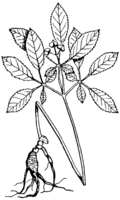 | Back to e-WV
| Back to e-WV
 The West Virginia Encyclopedia
The West Virginia Encyclopedia
 | Back to e-WV
| Back to e-WV
 The West Virginia Encyclopedia
The West Virginia Encyclopedia

American ginseng, a long-lived herbaceous perennial, is an important forest resource in West Virginia. It exists in all 55 counties but is most prevalent in cool, moist forests having well-drained loamy soils and a moderate to heavy tree canopy with a heavy understory of shrubs and herbs.
Ginseng grows from ten to 18 inches tall, with occasional specimens as tall as two feet. The plant has a distinctive olive green color which makes it stand out to the practiced eye. The compound leaves, each consisting of five parts, vary in number from one in very young specimens to as many as four in more mature plants. Ginseng diggers, often known as ‘‘sangers,’’ describe ginseng or ‘‘sang’’ by the number of prongs or leaf stems. The older plants have larger roots and more prongs. A four-prong plant will always elicit excitement among sangers.
The Chinese use the root for a wide variety of ailments including fatigue and pulmonary and gastrointestinal disorders. It is also employed as an aphrodisiac. It is mostly used in making a tea, but it is also carried as a dried root to ward off disease and promote good health. Recent biomedical research has isolated active compounds called saponin ginsenosides, which increase the efficiency of the adrenal and pituitary glands. Other active chemicals include panaxin, which stimulates brain function and aids heart and blood vessels; panacene, which acts as a painkiller and tranquilizer; and ginsenin, an anti-diabetic substance.
Ginseng has been harvested as a cash crop in West Virginia for at least 200 years. West Virginia has a harvesting season beginning on September 1 and ending on November 30 of each year. The statute requires diggers to plant the ripe berries (seeds) from harvested plants at the digging site.
Only dealers registered with the state Division of Forestry may export ginseng root from West Virginia. Ginseng sales produce $5 million to $6 million each year, an important income supplement in the southern coalfields and rural communities. Recent ginseng prices have ranged from a low of $175 to more than $500 per pound of dried root. Division of Forestry records indicate an average annual root harvest of nearly 20,000 pounds, with the highest occurring in 1984 at more than 39,000 pounds and the lowest in 1987 at nearly 9,500 pounds. McDowell County, the southernmost West Virginia county, has averaged the greatest harvest with Wyoming, Logan, Mingo, Boone, Raleigh, Kanawha, Greenbrier, Fayette, and Randolph counties completing the top ten.
Written by Robert D. Whipkey
Epler, John W. All about Ginseng. Hastings, NE: Cornhusker Press, 1985.
Harding, A. R. Ginseng and Other Medicinal Plants. Columbus: A. R. Harding, 1972.
Parsons, W. Scott. American Ginseng: Green Gold. Asheville: Bright Mountain Books, 1994.